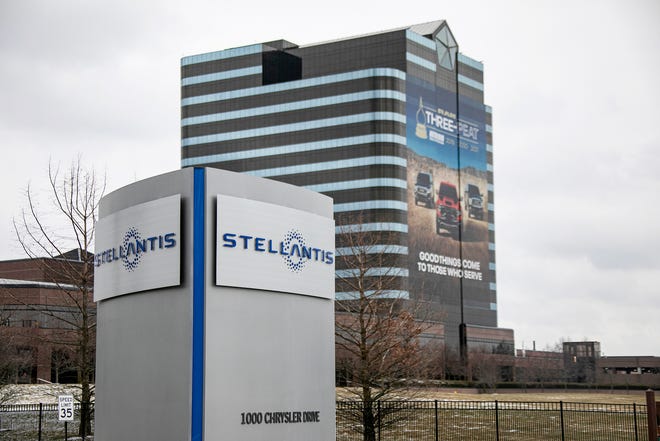Don’t expect to see a Peugeot dealership popping up down the block anytime soon.
That doesn’t mean the head of Stellantis, the new company formed from the merger this weekend of Fiat Chrysler Automobiles and PSA Group, won’t consider the possibility down the road.
But for right now, the closest most Americans might get to seeing the French brand in action is in old “Columbo” reruns. The famed TV detective played by the late Peter Falk way back in the ’70s tooled around in a Peugeot 403 that had seen better days. Today’s Peugeot models are a far cry from Lt. Columbo’s machine, but that doesn’t mean it makes sense to try to sell them here.

Stellantis CEO Carlos Tavares, in his first news conference leading what is now the fourth-largest automaker in the world trailing only Volkswagen, Toyota and the Renault-Nissan-Mitsubishi Alliance, noted on Tuesday the relative strength of FCA’s market share in the United States, above 12%, with its current stable of brands, led by Jeep, Ram, Chrysler and Dodge.
“It is possibly more important to focus on the profitable growth of those brands rather than bringing a new brand on top of what already exists, but we’ll see in the future,” Tavares said, noting that no final decision has been made.
One of the longtime goals for PSA Group had been a return to the U.S. market, and the company had even opened an office in Atlanta. Peugeot was last sold here in 1991.
What U.S. consumers are likely to see instead is the introduction of what Tavares called “sister cars.” Those would be vehicles that share components but remain distinct to the consumer. He gave as an example three current models from former PSA brands DS Automobiles, Peugeot and Citroen.
The focus on shared components gets at some of the numbers within the estimated $6 billion (5 billion euros) in annual synergies FCA and PSA Group said would result from the merger. Critics, however, fear that the synergies would mean the end of certain brands, such as Chrysler and Dodge, and job cuts.
Tavares sought to allay concerns on both fronts.
While not offering specifics, Tavares said brands would be given a “strong opportunity” to rebound based on the implementation of the synergies, 75% of which should come from planning, engineering, manufacturing and purchasing. The scale of the combined company and its 400,000 employees is key, he said.

With Stellantis, those brands that did not receive as much investment because of past priorities could benefit from the ability to make sister cars that are less expensive to introduce, “and that is going to create some significant business opportunities for certain brands,” Tavares said.
FCA, under the late Sergio Marchionne, had instituted a plan to invest more heavily in Jeep, Ram, Alfa Romeo and Maserati than in others.
Answering questions about Alfa Romeo and Fiat, another now former FCA brand that has underperformed in the United States, Tavares said he is “reasonably confident we can improve the situation.”
More:Welcome, Stellantis! Fiat Chrysler, Peugeot merge to create world’s 4th-largest automaker
More:Stellantis gets shareholder blessing; Fiat Chrysler, PSA merger could be complete in weeks
More:Chrysler’s great-grandson worries about fate of automaker as merger with Stellantis looms
Still, IHS Markit principal analysts Stephanie Brinley and Ian Fletcher, in comments on the merger, said some brands could remain at risk.
“Tavares has demonstrated in the past a willingness to abandon products that are unprofitable and Stellantis has more production capacity than it may need today. However, the expected cost-cutting targets enabled by the larger scale and improved purchasing power of the combination may ultimately mean that answer may not always simply be to drop troubled brands or products — instead there may be opportunity for some brands to see expanded product portfolios compared with today as a result of improved purchasing opportunities and scale effect,” Brinley and Fletcher wrote.
The merger was promoted as being able to create billions in synergies without plant closures, and Tavares recommitted to that position on Tuesday. In fact, he said jobs would have been in jeopardy without the merger.
“Stellantis is a shield,” he said several times.
There are “many more things to do in a car company than just cutting jobs,” he said.
Tavares said the company’s goal is to become carbon neutral, and he emphasized its intent to roll out more electric vehicles. He noted that the incoming Biden dministration would be more focused on emissions issues and that the company would be aligned with that effort.
Currently, the company claims 29 electrified models, with plans for 10 additional offerings by the end of this year and one electrified version for every new global model by 2025.
Stellantis shares closed at $16.88 Tuesday, the first day that Stellantis has been listed on the New York Stock Exchange.
Contact Eric D. Lawrence: elawrence@freepress.com. Follow him on Twitter: @_ericdlawrence. Become a subscriber.